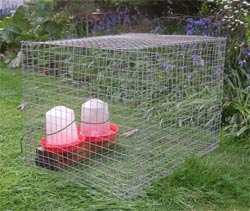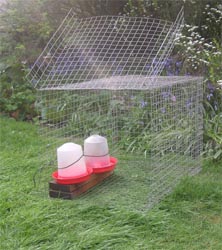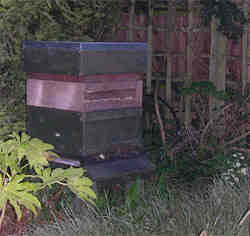How to make a broody coop to stop your chickens and bantams being broody (takes 1 hour to make)
Posted by Fiona Nevile in Chickens | 130 comments “Two of my hens are broody.” Bunty was exasperated.
“Two of my hens are broody.” Bunty was exasperated.
“We’ve got a broody one too.”
This was our first summer of keeping bantams (a small friendly breed of chicken).
Bunty continued, “I wish I hadn’t suggested Bantams. I’ve discovered that they go broody at the drop of a hat.”
Years ago Bunty had kept chickens commercially. Those were a type of chicken bred for laying that rarely go broody.
She thought that she had the answer to our dilemna.
“We need anti broody coops. You’re good at making things. Why don’t you make a couple?”
My heart sank. I thought that they would take hours to make, imagining a sort of dog kennel with a wide gauge wire mesh floor.
To stop a hen being broody you need to stop her from settling comfortably. The trick is to construct a cage with a floor made of large wire mesh ( with at least 1 inches squares). Set the cage on bricks so that the floor is suspended, keeping the bricks to the outside edges so that she can’t sit on them. Provide a small drinking fountain and feeder within the cage and pop her in. She won’t be able to settle on the wire mesh floor and within a few days will get over her broodiness.
I went to bed early and woke at four. In the still cold light I realised that the entire cage could be made of wire mesh. I went to the garden centre after breakfast and bought three sheets of wire mesh measuring 90cm x 60cm. The cage is 60 cm long and 43 cm high and 43 cm wide This allows for an overlap at the joins.
Our broody coop is simple to make. Lay the wire on a flat surface, and bend 2 cm of wire mesh to a 90 degree angle along a 60 cm side. Then lift the opposite end and press it into the angled flap. Press firmly on the bulgy end and fold flat to make a clean angle and pull the ends apart. You now have the floor and one side. Repeat the operation for the roof and the other side.The flap may seem a bit fiddly but it makes the cage much more rigid and stable.
Now attach the the two halves together to make the body of the cage. I tied the two together with twists of wire at 5cm intervals. The front and back of the cage are made from the remaining sheet. Hold the sheet against the opening at the back and cut to fit using wire clippers. The back was attached using wire twists. The front is hinged at the top with sides that bend back a bit over the sides of the cage.
Having a hinge at the top makes it easier to put the chicken in the cage. If you put her in headfirst you can quickly drop the door down and secure it with pegs before she has turned around. We used clothes pegs but small bulldog clips would be good for a larger chicken.

The broody coop in the photo is the mark one version. I made Bunty a Rolls Royce (mark two) cage out of plastic coated wire. Definitely worth the extra investment as it’s stronger and more durable. Carol (our Maran) has never been broody. If she was, I’d make her a bigger cage (the hen needs to be able to stand up). And it would have to be stronger than the mark one cage as she is a much larger bird than the bantams.
Our broody coop sits in the Day Centre. Bunty had hers in the run with a bit of wood as a roof.
It took me a while to realise when the perfect moment of release should take place. The chicken in the broody coop will ask to be released immediately. But bide your time. Her comb will gradually change from pink to red. When it is red she can get out of jail. If you release her while her comb is still pink she will nip back to the nesting box and you will have to start the process all over again.
If you have a broody chicken and you want her to sit on fertilised eggs put a floor on the bottom of the broody coop, fold the door over the roof and you have a quiet area in which she can sit for twenty one days, with easy access to food and water. She needs to be able to move away from the nest so don’t lock her in. Ideally, place the cage somewhere that is protected from the elements. Or construct a simple roof like Bunty did (a bit of plywood slightly bigger than the cage). It’s not a good idea to let a broody hen stay in the nesting box as it puts the other hens off laying eggs.
Leave a reply






did you make sure the coop is completely off the ground so there is always cold air underneath her and she cant settle? i have used mine twice now and its worked both times. make sure whatever it sits on is right at the edge as she may try and sit on your bricks or wood as well. did you keep her in it all the time day and night as well? if its yes to all these then i am sure you will get a message about leaving her in longer from FN. good luck.
I have a broody Black Rock, she has been brrody for a few days now so I have decided to go to a farm and get her some fertilised eggs to sit on. Unfortunately we only have one nesting box in the chicken house so she is being moved out of there everytime our other chicken (Pig!) wants to lay. It seems that both the chickens and our 2 chicks sleep in the nesting box as well. Do I need to move her out of the nesting box to hatch the eggs or will they be ok with all the activity going on? Thanks in advance you have been very dedicated to this blog for three years now which can only be applauded! Xx
I have a broody chicken and she has been in the broody coop for a week now, her comb goes red and I let her out only for her to run back to the nesting box and stay put. Whilst on the box her comb goes a lighter shade of red and her feathers fluff up and she clucks at me. I remove her and put her back in the broody coop – is it okay for her to stay in the coop for longer than 1 week?
Hi Miranda
Bring the cage into your bathroom?
Hello Simon
Great news that it worked for you!
hi again, after 3 days i have just let my brood silkie out and she is back to normal again!! thanks very much she was stuck in the nest box for nearly 3 weeks before i built the coop ( after trying numerous other suggestions) for anybody else, make sure you keep your girl in it day and night!!, i put a big cover over the cage which seemed to do the trick at night although i felt a bit bad leaving her in a cage on her own when the rest went to bed but its only 3 days and now she is back with the rest. thanks again!!
dang. if only i had a shed or garage to use.
i have a broody hen presently – i have one question. we’ve been keeping her in her broody coop (a rabbit cage on top of a bucket type pan) all day for abotu 3 days. We bring her in at night to sleep in the bath tub – will that nix the affect of the broody coop? i just hate to have her in such a flimsy affair at night at risk of predators.
please advise.
Hi Miranda
She need to be kept in the broody coop at all times! If necessary move the broody coop into a garage or shed at night. If you let her sleep in the bath you are negating the point of the broody coop and she will remain broody and unhappy for longer.
hi there, i have built your broody coop today for a broody silkie. my only problem is how can i tell when she is going to be ok to be released as she has no comb on her head and only blue pieces (are the called waffles?) on her jaw. obviously these are not pink! any suggestions? any help is appreciated. thank you
Hi Simon
If I was you I’d keep her in the anti broody coop (with food and water) for three days. Then let her out and if she rushes back to the nest box pop her back into the coop for a few more days and so on. She will get over her broodiness in time 🙂
I got my 4 hens last Oct and one started being broody in March. After trial and error (not knowing about the Moody/Broody cage) I finally gave in and got 3 fertilised eggs, which have just hatched 48 hours ago! What do I do now? They have chick crumb which I was advised to mix with water, but they only seem to like it dry. Mum loves it too. What happens now? How do I introduce them to their aunties and keep them safe? They’ve taken up residence in the nesting box but Ive made the others a new nesting box next door by making a partition with half a cardboard box and they seem fine with that. Laying happily if noisily! Any advice please?
Hi Alison and Peter
There’s no need to add water to the chick crumbs! But check the crumbs evey few hours as the chicks will poop in them. They need access to a small water fountain with sound stones/marbles in the bottom so they can’t drown.
The mother and babies need to be separated from the rest of the flock until they are big enough to stand up for themselves – around three months old. So they need a their own pen and house ideally. We use a chicken ark for our mothers and chicks. Don’t use hay in their house as it can cause respiratory diseases – we use wood chips (the sort that are used for rabbits etc).
Apart from that the mother hen will look after the chicks. Keep feeding the chick crumbs as these contain elements to protect the chicks from disease.
hi, i am a very new chook keeper, i have three pekin bantams, two of which have decided to go broody, i have tried taking them off the nest several times a day but this did not help, so now i have used my dogs cage and put this up on bricks and put in run so that the other one is not on its own, they have been in there nearly two days, on the first night i put them back to sleep in the coop, but i was wondering if this was a good thing. please can someone advise if i should leave them out in the pen all night, if so will they be ok as the nights are quite cold also will the one on its own be ok.
sorry to sound a bit soft, but really want to do things for the best health of my chooks